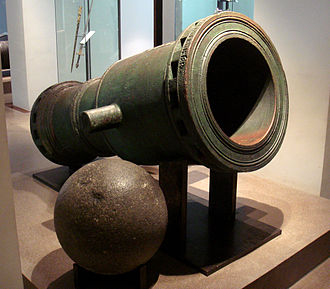Bombard mortar and granite ball projectile of the Knights of Saint John of Jerusalem, Rhodes, 1480–1500. Founded at the request of Pierre d’Aubusson, the bombard was used for close defense of the walls (100–200 meters) at the Siege of Rhodes. It fired 260 kg granite balls. The bombard weighs about 3,325 kg. Musée de l’Armée.
Mons Meg is a medieval bombard located at Edinburgh Castle, Scotland. It was built in 1449 on the orders of Philip the Good, Duke of Burgundy and sent by him as a gift to King James II of Scotland in 1454. The bombard was employed in sieges until the middle of the 16th century, after which it was only fired on ceremonial occasions
Early gunpowder artillery was known by a bewildering variety of names. (The word cannon became dominant only gradually, and the modern use of the term to describe a gun large enough to fire an explosive shell did not emerge until the 20th century.) The earliest efficient wrought-iron cannons were called bombards or lombards, a term that continued in use well into the 16th century. The term basilisk, the name of a mythical dragonlike beast of withering gaze and flaming breath, was applied to early “long” cannons capable of firing cast-iron projectiles. Early cannon terminology being anything but consistent, however, any particularly large and powerful cannon might be called a basilisk.
Founders had early adopted the practice of classifying cannons by the weight of the ball, so that, for example, a 12-pounder fired a 5.4-kg (12-pound) cannonball. By the 16th century, gunners had adopted the custom of describing the length of a cannon’s bore in calibres, that is, in multiples of the bore diameter. These became basic tools of classification and remained so into the modern era with certain categories of ordnance such as large naval guns. Also by the 16th century, European usage had divided ordnance into three categories according to bore length and the type of projectile fired. The first category was the culverins, “long” guns with bores on the order of 30 calibres or more. The second was the cannons, or cannons-of-battery, named for their primary function of battering down fortress walls; these typically had barrels of 20 to 25 calibres. The third category of ordnance was the pedreros, stone-throwing guns with barrels of as little as eight to 10 calibres that were used in siege and naval warfare.
Mortars were a separate type of ordnance. With very wide bores of even fewer calibres than those of the pedreros, they were used in siege warfare for lobbing balls at a very high trajectory (over 45°). Mortars owed their name to the powder chamber of reduced diameter that was recessed into the breech; this made them similar in appearance to the mortars used to pulverize grain and chemicals by hand. Unlike the longer cannon, mortars were cast with trunnions at the breech and were elevated by placing wedges beneath the muzzle.
SPECIAL-PURPOSE SHOT
Both culverins and cannons-of-battery generally fired cast-iron balls. When fired against masonry walls, heavy iron balls tended to pulverize stone and brick. Large stone cannonballs, on the other hand, were valued for the shock of their impact, which could bring down large pieces of wall. Undercutting the bottom of a wall with iron cannonballs, then using the heavy impact of large stone shot to bring it down, was a standard tactic of siege warfare. (Ottoman gunners were particularly noted for this approach.)
In the 15th century exploding shot was developed by filling hollow cast-iron balls with gunpowder and fitting a fuze that had to be lit just before firing. These ancestors of the modern exploding shell were extremely dangerous to handle, as they were known to explode prematurely or, with equally catastrophic results, jam in the gun barrel. For this reason they were used only in the short-bored mortars.
For incendiary purposes, iron balls were heated red-hot in a fire before loading. (In that case, moist clay was sometimes packed atop the wadding that separated the ball from the powder charge.) Other projectiles developed for special purposes included the carcass, canister, grapeshot, chain shot, and bar shot. The carcass was a thin-walled shell containing incendiary materials. Rounds of canister and grapeshot consisted of numerous small missiles, usually iron or lead balls, held together in various ways for simultaneous loading into the gun but designed to separate upon leaving the muzzle. Because they dispersed widely upon leaving the gun, the projectiles were especially effective at short range against massed troops. Bar shot and chain shot consisted of two heavy projectiles joined by a bar or a chain. Whirling in their trajectories, they were especially effective at sea in cutting the spars and rigging of sailing vessels.
GUNNERY
During most of the black-powder era, with smoothbore cannons firing spherical projectiles, artillery fire was never precisely accurate at long ranges. (Aiming and firing were particularly difficult in naval gunnery, since the gunner had to predict the roll of the ship in order to hit the target.) Gunners aimed by sighting along the top of the barrel, or “by the line of metals,” then stepped away before firing to avoid the recoil. The basic relationship between range and elevation being understood, some accuracy was introduced through the use of the gunner’s quadrant, in which the angle of elevation of a gun barrel was measured by inserting one leg of the quadrant into the barrel and reading the angle marked on the scale by a vertically hanging plumb line.
Nevertheless, the inherent inaccuracy of smoothbore artillery meant that most shooting was done at short ranges of 900 metres (1,000 yards) or less. At these ranges, estimating elevation by rule of thumb was sufficient. For attacking fortress walls, early modern gunners preferred a range of 55 to 75 metres (60 to 80 yards); a range of 90 to 135 metres (100 to 150 yards) was acceptable, but 270 metres (300 yards) or more was considered excessive.
